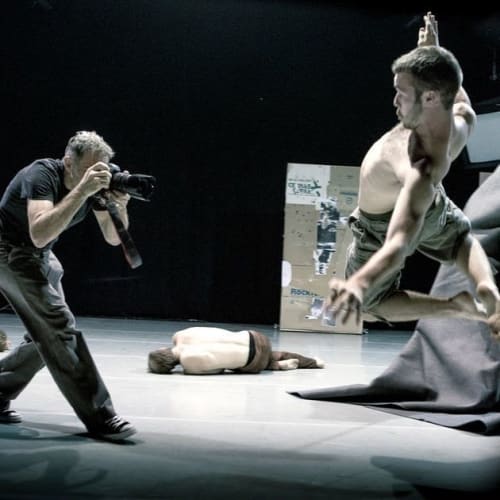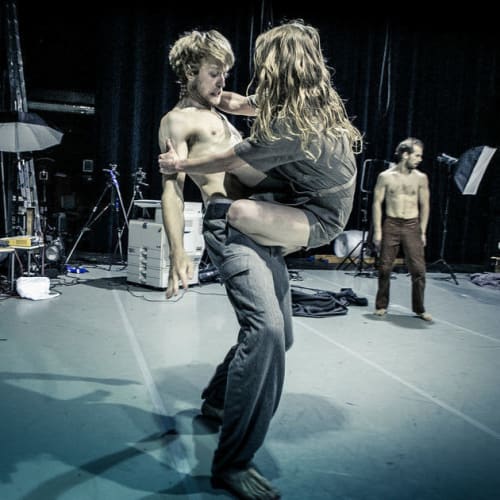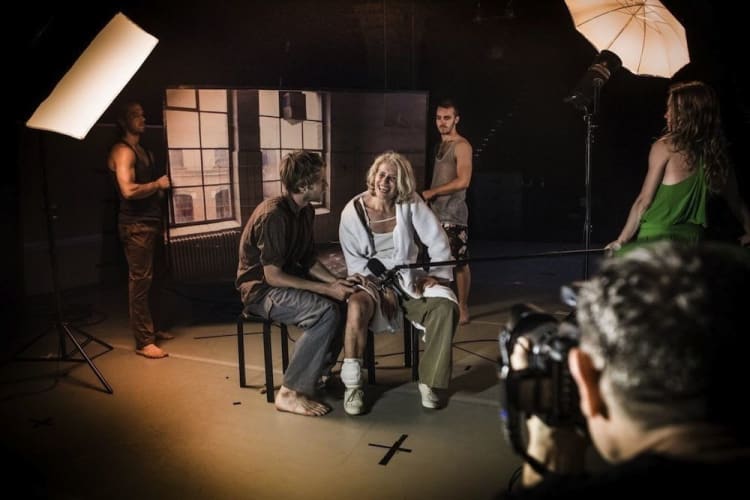For a quarter of a century, Belgian choreographer Wim Vandekeybus has been making performances, he says, not dance pieces, performances that question what and why.
Coming, as he says he does, more from theatre and film, and, one might add, an abandoned psychology degree, his confrontational multimedia pieces push at the boundaries.
“For me it is important that we work with physical and mental aggression. To make the public question the authenticity of things.”
Questioning the authenticity of things is at the heart of booty Looting, not only in the Picasso sense of ‘good artists copy, great artists steal’, but also in the sense of false memory.
“Memories are often created or distorted on the basis of photographs. Proust once accused the visual memory of actually erasing memories… Which is why you can perfectly well remember things you have never experienced, simply because you have seen pictures of them.”
Thus speaks Vandekeybus. But I’ll remember booty Looting for its fabulous stream of images, anecdotes, moves, inventive interrogation, anarchic humour, its crazy energy, pinball machine zing, its Gordian knot of references, and dancers who look as if they’ve come in off the street.
Spinning a postmodern yarn two hours long with no interval, we may only understand some of the references, but that’s fine, we can believe as much or as little as we like.
The set is a working studio with its paraphernalia detritus, lights, screens, photocopier, felt blanket, broom. ‘Joseph Beuys’ are the first words in my notebook...
Belgian 'rock' photographer Danny Willems hovers silently over the action, his images projected on a screen hanging at the back. To one side sits music composer Elko Blijweert with his guitar and electronic equipment, who produces a crashing cinematic score seemingly on demand.
“Music, movement, spoken word and photography are on an equal footing with each other. Every medium adds something or erases something.”
Three young men, a young and older woman mill around, waiting to start. On comes Jerry Killick (a Forced Entertainment actor), who reminds me of a young Simon McBurney, even more so as the piece unfolds in early Complicite style.
This storyteller is going to recreate for us the myth of Joseph Beuys’s famous 1974 performance I like America and America likes me, and its origins.
Coyotes circle and attack Beuys in his wigwam made of felt and antennae broom. In free and easy comic lolloping gait. But then the tale gets taller with the introduction of anthropologist and artist Birgit Walter. Who is she?
An Aryan Leni Riefenstahl figure? Arrogant, demanding, she speaks of her studies of the Tartar people, who ‘saved’ Beuys. Birgit Walter is the actress (from the Schauspiel Köln theatre ensemble) in the role.
But why is this Birgit Walter masquerading as artist Lili Fischer? Reality and fantasy, do we know the difference? Does it matter?
Several scenarios seem to be taking place at once. Dancers speak and tumble in daredevil parkour combat rolls and twisting leaps, as the narrator eyes the audience.
Actors and artists appropriate, is homage stealing, too? A biography of this Birgit Walter is concocted—she’s a bad mother, she only likes alpha males, where is this leading? I write down ‘Medea’.
Faces are tied up, necks are slashed, a girl cries, photos accrue on a board, creating a Frankenstein monster. Fingers wriggle in cryptic animalistic signing—savage children in a Greek drama?
Les enfants terribles unleash their force: makeshift toys, madness, mayhem and acrobatics in a children’s playroom. Spin the bride. Why do the boys poke out their ‘mother’s’ eyes?
Where do Georges-Henri Clouzot and his unfinished 1964 film L’Enfer fit in this? Its lead characters’ names were taken from Proust’s À la recherche du temps perdu. Is that it?
The dancers dance up a storm, whilst Birgit Walter transforms herself into Medea in a fashion shoot at the back. Death by Xerox—she kills her sons, their smashed face copies projected for all to see. Eyes kohl-black, she speaks the part of Maria Callas in Pasolini’s Medea film.
Can we believe anything we see? Can we believe Joseph Beuys’s story? Some still persist in believing that myth even though it has been discredited, but is there an intrinsic truth in its shamanistic ideal?
Time to unmask the tricks of the trade, take off those kneepads, strip naked, stop misleading us. Switch off the music that swells the drama.
Only two shows in London, dance installation booty Looting deserves a look.


